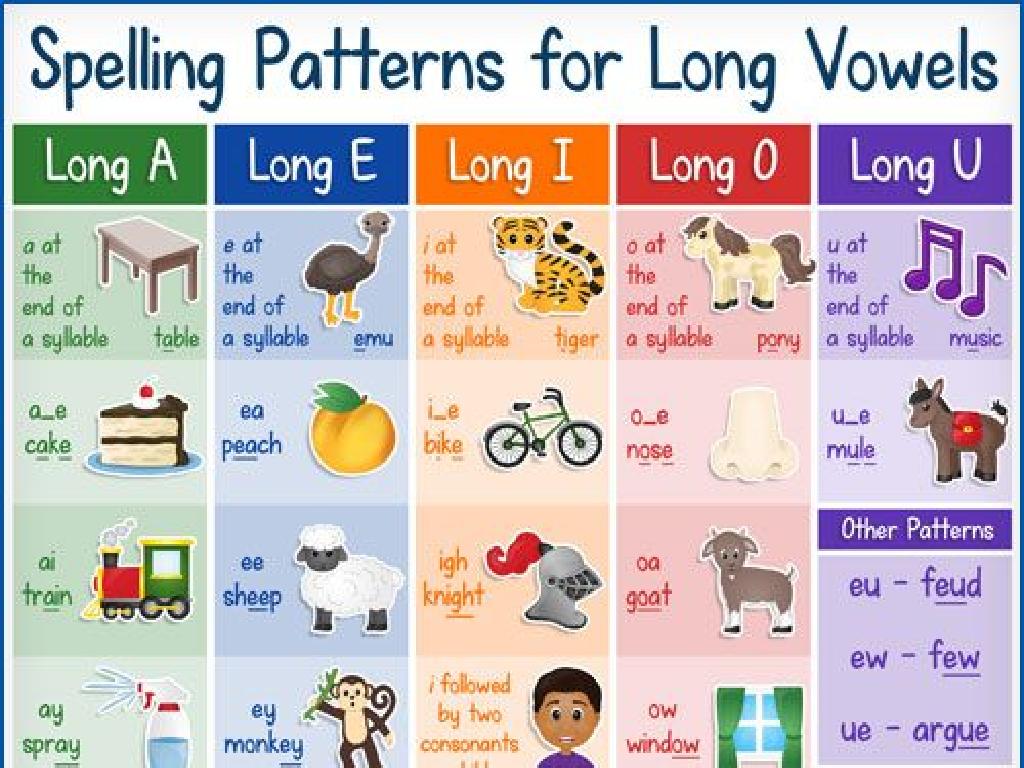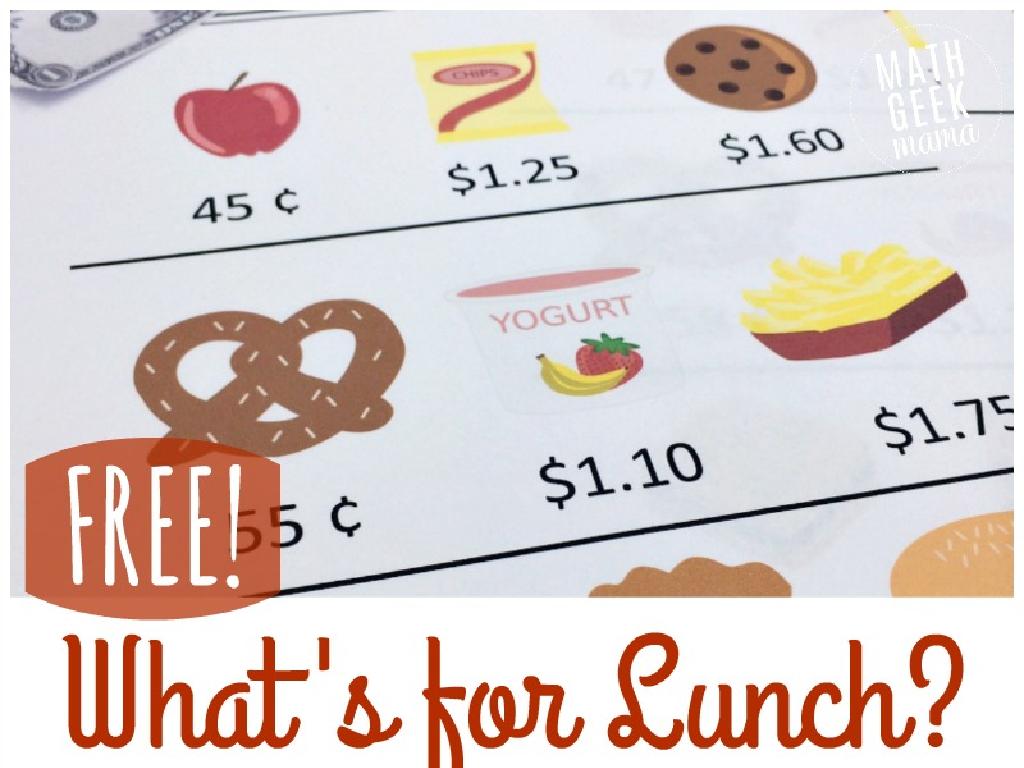Interpret Bar Graphs I
Subject: Math
Grade: First grade
Topic: Data And Graphs
Please LOG IN to download the presentation. Access is available to registered users only.
View More Content
Exploring Bar Graphs
– What is a bar graph?
– A chart with bars showing data
– Bar graphs display information
– Each bar represents a quantity
– Bar graphs help us compare
– We can see which has more or less
– Easy counting with bar graphs
– Count the bars to find amounts
|
Begin the lesson by introducing bar graphs as a tool for displaying data in a visual format that is easy to understand. Explain that each bar on the graph represents a different quantity, and the height of the bar shows how much or how many. Use simple examples, like comparing the number of apples to oranges, to illustrate how bar graphs can help us compare different sets of data. Emphasize that bar graphs make counting and comparing quantities easier, even for complex information. Encourage students to think of situations where they have seen bar graphs, like in games or when talking about the weather.
Understanding Bar Graphs
– Bar graphs show amounts with bars
– They help us compare things easily
– Which has more: 5 apples or 3 oranges?
– Each bar represents a number
– Example: Comparing fruits in a basket
– Picture 5 apples vs. 3 oranges as bars
|
This slide introduces the concept of bar graphs to first graders. Begin by explaining that a bar graph is a way to show numbers or amounts using bars, making it easier to see and compare different things. For example, if we have apples and oranges, we can use a bar graph to show which we have more of. Each bar on the graph stands for a different number of things. Use simple, relatable examples, such as comparing the number of different fruits in a basket, to illustrate how bar graphs work. Encourage the students to think about what each bar means and how taller bars show bigger numbers. This visual representation helps them grasp the concept of comparison and quantity.
Parts of a Bar Graph
– Title: What the graph shows
– Categories: Things we count
– Like types of fruits or colors
– Bars: Show the quantity
– Taller bars mean more items
– Understanding bar graph parts
– Helps us read and make graphs
|
This slide introduces the basic components of a bar graph to first-grade students. The title of a bar graph tells us the subject or the main idea of what the graph is about, such as ‘Favorite Fruits’. Categories are the groups or types of items we are comparing, like apples, bananas, and oranges. The bars represent the amount of each item, and their height shows us how many there are; taller bars mean more of that item. Understanding these parts is crucial for students to interpret and create their own bar graphs. Use simple and relatable examples to illustrate each part, such as a bar graph showing the number of different colored balloons. Encourage students to ask questions and think of items they could count and represent on a bar graph.
Reading a Bar Graph
– Observe each bar’s height
– Taller bars mean more quantity
– Counting with bar heights
– Each bar’s height equals a number
– Practice by counting together
– We’ll count items represented by bars
|
This slide introduces students to the concept of reading bar graphs. Begin by explaining that bar graphs are a way to show numbers and compare amounts. Show them that the height of each bar represents how many there are of something, and that a taller bar means there is more of that item or category. Encourage the students to observe and compare the heights of different bars. Then, lead the class in a counting exercise using the bar graph, helping them to understand that each step up on the graph represents one more of the item being counted. This will help them to visually and numerally understand the concept of quantity as represented on a bar graph. Finish with a group activity where students count items on a bar graph together, reinforcing the lesson.
Making Our Own Bar Graph
– Choose our favorite colors
– Count classmates’ color choices
– How many friends like red, blue, etc.?
– Draw bars for each color
– Taller bars show more popular colors
– Understand what our graph shows
|
This activity is designed to introduce first graders to the concept of bar graphs. Start by asking each student to pick their favorite color. Then, as a class, tally the number of students that prefer each color. Use this data to help the students draw bars on the graph paper, with each bar representing the number of students that like a particular color. The height of each bar will correspond to the number of students. This visual representation helps students understand that bar graphs are a way to show numbers and compare information. After completing the graph, discuss with the students what the graph tells us about their favorite colors as a class. For example, which color is the most popular or the least popular? This will help them interpret the data. Provide guidance and ensure each student is engaged and understands the steps.
Class Activity: Our Favorite Fruits Bar Graph
– Share your favorite fruit with the class
– Watch as we draw the bars on our graph
– See which fruit is the most popular
– Learn how to read a bar graph
|
This interactive class activity is designed to introduce first graders to the concept of bar graphs in a fun and engaging way. Start by explaining what a bar graph is and how it can be used to represent data visually. Then, ask each student to name their favorite fruit and record the responses. As you collect the data, draw the corresponding bars on the graph, making sure each bar’s height represents the number of students who like that fruit. This visual representation will help students understand how bar graphs work and how to interpret them. Encourage participation and ensure that every student’s input is included. After completing the graph, discuss the results with the class, pointing out which fruit is the most popular and why bar graphs are useful. Prepare to offer guidance on how to read the graph, such as understanding the x-axis and y-axis, and the significance of the bar heights.
Review: Understanding Bar Graphs
– Bar graphs have titles
– The title tells us what the graph is about
– Easy comparison of amounts
– Look at the bars to see which is taller or shorter
– We can create our own graphs
– Use bars to represent things we count
– Graphs about our favorite things
|
This slide is a recap of our previous lesson on bar graphs. Emphasize the key parts of a bar graph: the title, which explains what the graph is about; the categories, which are the different things we are comparing; and the bars, which show the amounts. Explain how bar graphs make it easier to compare different amounts by simply looking at the height of the bars. Encourage students to think of things they like, such as pets, colors, or toys, and imagine how they could represent this information using a bar graph. This will help them understand how data is organized visually and how it can be used to convey information in a simple and effective way.
Let’s Play a Game with Bar Graphs!
– Quick bar graph reading game
– Identify the ‘most’ category
– Which bar is the tallest?
– Find the ‘least’ category
– Look for the shortest bar
– Ready, set, go!
|
This interactive game is designed to help first graders practice reading bar graphs quickly and accurately. Display a simple bar graph on the board and ask students to identify which category has the most or the least based on the height of the bars. This will help them visually understand the concept of quantity comparison in a fun and engaging way. Prepare several examples of bar graphs with different categories and levels of complexity. Make sure to praise quick and correct responses to encourage participation and excitement. This activity will not only reinforce their understanding of bar graphs but also improve their observational skills and reaction time.
Bar Graphs: Show What You Know!
– Super work on bar graphs today!
– Homework: Create your toy bar graph
– Count your toys and draw bars to match
– Title your graph and label it
– Name your graph and what each bar stands for
– Share your graph with the class tomorrow
|
Today’s lesson was an introduction to bar graphs, which are a visual way to show information. For homework, students will apply what they’ve learned by creating their own bar graph based on the toys they have at home. This will help reinforce their understanding of how to represent data visually. Remind them to give their graph a clear title that explains what the graph is about and to label each category on the graph so we know what each bar represents. Encourage creativity and praise their efforts in class the next day as they present their graphs. This activity will not only solidify their grasp of bar graphs but also enhance their presentation skills.






